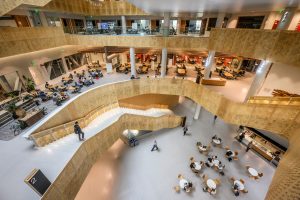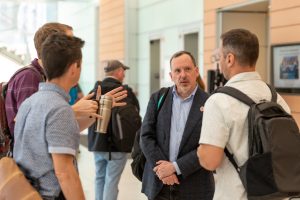A message from Didier Contis, vice provost for information technology and chief information officer:
I’ve had countless meetings over the past 4 months—a couple hundred calendar invites, conference room reservations and Teams links. If you asked me how much coffee I’ve consumed while getting to know this university’s IT landscape, I honestly couldn’t tell you. (I’m grateful Madison has so many high-quality cafes, especially Fair Trade Coffee, Valentia Coffee and Aldo’s Cafe—with special appreciation to the Aldo’s baristas who prepare my double espresso when they see me coming in the morning.)

Those meetings have taken me to every corner of the university—from the studios in Vilas to the remarkable facilities in Nancy Nicholas, to Bascom, Agricultural Hall, the Health Sciences Learning Center, the Unions and the dazzling new Morgridge Hall. Each visit shows me just how many places and people are still to discover.
Wherever I find myself each day, I’m always deeply impressed by the people here and how they connect IT work to UW–Madison’s core mission. IT professionals aren’t just maintaining systems or troubleshooting tickets; they’re thinking about how technology supports groundbreaking research, makes learning more accessible for students, and extends the university’s impact across Wisconsin and beyond. That sense of purpose appears everywhere, often in unexpected ways.
Many of my most valuable experiences haven’t come from scheduled meetings. They’ve come from chance encounters on State Street, at the Onsite Help Desk or during informal moments between meetings. Those small moments when someone stops to say hello, introduce themselves or share a quick thought matter more than you might think.
The power of being heard
Our listening sessions this fall have reinforced something important for me: people want connection—with leadership and with each other. They want to share their experiences, have their concerns heard and taken seriously, and have a role in shaping what comes next. I’ve heard the message over and over again—people want ongoing opportunities to engage and contribute.

I’ve also been happy to see that most people aren’t expecting me to have all the answers or fix everything—at least not right away. One participant said it directly: “I know you can’t solve all these problems. But it means something just to be asked.”
That message has been quite meaningful for me. I’ve been in higher education IT long enough to know that in leadership, especially the higher up you go, it’s easy to lose touch with the people doing the work. It’s easy to fall into an echo chamber where you’re only hearing from other leaders or from people who have the loudest voices. You can start making decisions based on incomplete information, disconnected from the daily reality of the people you’re supposed to serve.
So I’m trying to stay grounded. Being approachable and open is an important part of my role. Because even when problems are intractable, even when I can’t wave a magic wand and make everything better, staying connected to people keeps my thinking honest.
And what I’m hearing matters. When someone describes the IT Support Symposium as an example of ground-up collaboration that really works, that helps ground decisions about where to invest our energy and resources. When people point out communication gaps or suggest ways to build “connective tissue” between teams, those insights shape how we move forward together.
What’s ahead
These connections—formal and informal—are happening more often now. People recognize me around campus and stop to chat. And honestly, I love it when those conversations take surprising turns to something other than IT infrastructure. Apparently, admitting you’re most productive while listening to Metallica makes an impression. These small human moments create connection. They break down walls between leadership and staff by giving each other something other than work to latch onto, reminding us we’re all just people. People trying to do good work in the service of students, faculty, staff and each other.
I’m still learning. Still discovering. Still meeting new people and finding new corners of this remarkable university. The work ahead is complex—infrastructure that needs modernization, processes that need improvement, relationships that need strengthening. But I’m increasingly confident we have the right people, the right spirit and the right willingness to tackle those challenges together.
What I’ve heard over these past months will inform the decisions we make going forward. Not just what I’ve learned in listening sessions, but all the conversations along the way—in meetings, hallways, bus stops and cafes. People want connection. They want to know this isn’t performative, that we’re actually going to do something with what we’re learning together.
I’m committed to that.
— Didier
